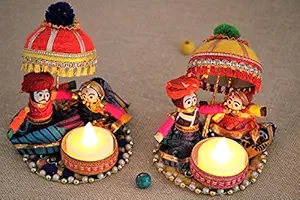મા પાવા તે ગઢ થી ઉતર્યા મહાકાળી રે
વસાવ્યું ચાંપાનેર, પાવા વાળી રે
મા ચાંપા તે નેરના ચાર ચૌત મહાકાળી રે
સોનિડે મંડ્યા હાથ, પાવા વાળી રે
મા, સોનિડો ટાઉ લાવે ઝાંઝરી મહાકાળી રે
મારી અંબે મા ને કામ, પાવા વાળી રે
મા ચાંપા તે નેરના ચાર ચૌત મહાકાળી રે
માલિડે મંડ્યા હાથ, પાવા વાળી રે
મા, માલિડો ટાઉ લાવે ફૂલડા મહાકાળી રે
મારી કાલિકા મા ને કામ, પાવા વાળી રે
મા ચાંપા તે નેરના ચાર ચૌત મહાકાળી રે
દોશિડે મંડ્યા હાથ, પાવા વાળી રે
મા, દોશિડો ટાઉ લાવે ચૂંદી મહાકાળી રે
મારી તુલજા મા ને કામ, પાવા વાળી રે
મા ચાંપા તે નેરના ચાર ચૌત મહાકાળી રે
ગાંધીડે મંડ્યા હાથ, પાવા વાળી રે
મા, ગાંધીડો ટાઉ લાવે કંકુડા મહાકાળી રે
મારી બહુચર મા ને કામ, પાવા વાળી રે
મા પાવા તે ગઢ થી ઉતર્યા મહાકાળી રે
વસાવ્યું ચાંપાનેર, પાવા વાળી રે
Overview of "Ma Pava Te Gadh Thi Utarya Mahakali Re"
Title & Meaning
'Ma Pava Te Gadh Thi Utarya Mahakali Re' is a traditional Gujarati Garba song praising Goddess Mahakali descending from Pavagadh.
Artist & Recording Details
Sung by various folk and devotional singers of Gujarat, this Garba is performed in Navratri events and cultural gatherings.
Genre & Occasion
This devotional folk Garba is dedicated to Goddess Mahakali and is especially popular during Navratri.
Language & Dialect
The song is in Gujarati with regional dialect influence, carrying deep cultural roots.
Popularity & Versions
This Garba is widely recognized across Gujarat and performed both in live Garba and recorded albums.
Lyrics Structure & Themes
Devotional Invocation
The lyrics begin by invoking Goddess Mahakali with reverence as she descends from Pavagadh.
Repetitive Chorus
The repeated chorus emphasizes rhythm and group participation, suitable for Garba dance circles.
Imagery & Symbolism
The imagery depicts Mahakali’s divine energy and cultural significance of Pavagadh hill.
Community & Togetherness
The song highlights collective celebration of faith, culture, and unity during festivals.
Emotional Resonance
Lyrics inspire joy, devotion, and spiritual strength in devotees.
Musical & Performance Elements
Instrumentation & Rhythm
Traditional instruments like dhol, tabla, and clapping give the song its festive rhythm.
Tempo & Dynamics
The song builds from steady beats to fast tempo, matching Garba dance energy.
Live vs Studio Renditions
Live versions often include extended chanting, while studio recordings are shorter and polished.
Dance Cues & Movements
The lyrics and beats guide circular Garba movements, spins, and synchronized clapping.
Audience Participation
Encourages mass singing, clapping, and group dancing for devotional joy.
Festival & Cultural Significance
Navratri Connection
This Garba is a highlight of Navratri, especially in regions close to Pavagadh.
Spiritual Meaning
The song glorifies Goddess Mahakali’s power and divine blessings for devotees.
Preservation of Folk Culture
This Garba preserves Gujarati traditions and connects younger generations to their roots.
Community Bonding
It strengthens social unity as people come together to sing and dance.
Joyful Experience
The song creates a spiritual and joyful atmosphere in Navratri celebrations.
How to Use & Share
Translations & Transliteration
Translations into Hindi/English make this Garba accessible to non-Gujarati devotees.
Audio / Video Embeds
Embedding videos and audio helps users enjoy and experience live Garba performances.
Printable Lyrics & PDF Downloads
Offering PDF lyric sheets supports devotees in community singing and events.
Performance Tips & Dance Guides
Provide Garba dance steps, costume tips, and rhythm guidance for performers.
SEO & Social Sharing Enhancements
Use keywords like Garba, Mahakali, Pavagadh, Navratri songs; enable easy sharing on social media.
'Ma Pava Te Gadh Thi Utarya Mahakali Re' is a traditional Gujarati Garba song praising Goddess Mahakali descending from Pavagadh.
Sung by various folk and devotional singers of Gujarat, this Garba is performed in Navratri events and cultural gatherings.
This devotional folk Garba is dedicated to Goddess Mahakali and is especially popular during Navratri.
The song is in Gujarati with regional dialect influence, carrying deep cultural roots.
This Garba is widely recognized across Gujarat and performed both in live Garba and recorded albums.
The lyrics begin by invoking Goddess Mahakali with reverence as she descends from Pavagadh.
The repeated chorus emphasizes rhythm and group participation, suitable for Garba dance circles.
The imagery depicts Mahakali’s divine energy and cultural significance of Pavagadh hill.
The song highlights collective celebration of faith, culture, and unity during festivals.
Lyrics inspire joy, devotion, and spiritual strength in devotees.
Traditional instruments like dhol, tabla, and clapping give the song its festive rhythm.
The song builds from steady beats to fast tempo, matching Garba dance energy.
Live versions often include extended chanting, while studio recordings are shorter and polished.
The lyrics and beats guide circular Garba movements, spins, and synchronized clapping.
Encourages mass singing, clapping, and group dancing for devotional joy.
This Garba is a highlight of Navratri, especially in regions close to Pavagadh.
The song glorifies Goddess Mahakali’s power and divine blessings for devotees.
This Garba preserves Gujarati traditions and connects younger generations to their roots.
It strengthens social unity as people come together to sing and dance.
The song creates a spiritual and joyful atmosphere in Navratri celebrations.
Translations into Hindi/English make this Garba accessible to non-Gujarati devotees.
Embedding videos and audio helps users enjoy and experience live Garba performances.
Offering PDF lyric sheets supports devotees in community singing and events.
Provide Garba dance steps, costume tips, and rhythm guidance for performers.
Use keywords like Garba, Mahakali, Pavagadh, Navratri songs; enable easy sharing on social media.


